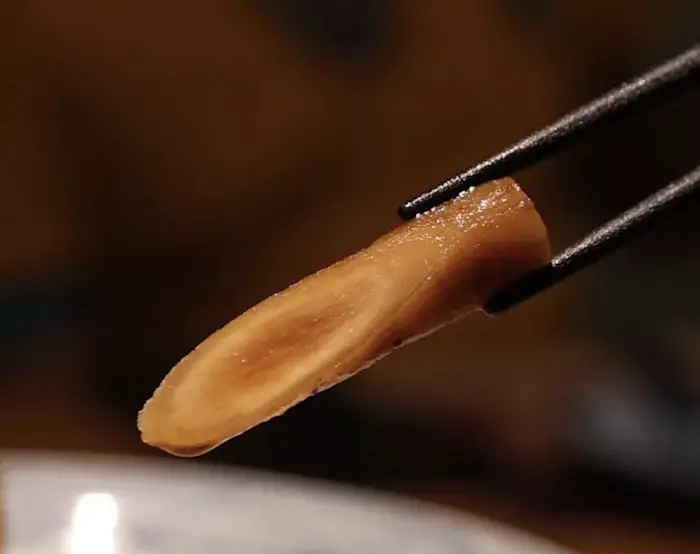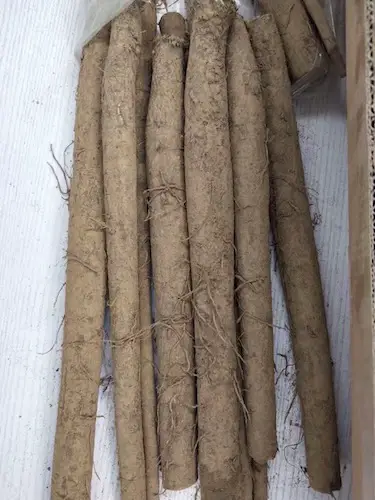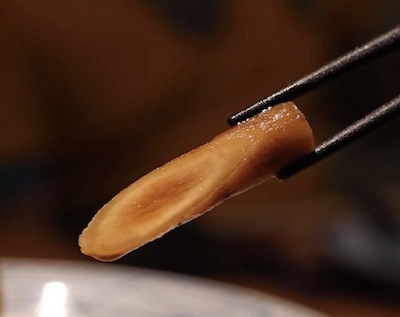We are reader supported. When you purchase through links on our site, we may earn an affiliate commission. Also, as an Amazon affiliate, we earn from qualifying purchases.

If you are a crazy sushi fan like me then you have probably tried every possible ingredient including fish, seafood, meat, vegetables and fruits on earth. While I don’t mind retrying them, I am always on the lookout for some new and exciting ingredients. Today I will tell you about my latest discovery – Gobo sushi that I had in a restaurant lately.
You may ask ‘What is Gobo in sushi’. Gobo is a fun name for Japanese Burdock root aka artichoke that has a crispy, earthy, and sweet taste. The physical appearance resembles daikon radish but the flavor is much milder and sweeter. You can also find yamagobo in sushi rolls. These are pickled Burdock root, colored to make them look like carrots.
The Burdock plant belongs to the artichokes and sunflowers family. Its appearance is like a weed with purple stems and spiny leaves. While the leaves are not very aesthetic, you don’t have to worry about how it looks on the outside because it’s the root we consume.
The delicious roots are slender and long, growing up to 3 feet in length and they grow around the world. Hence, no matter which part of the world you live, you can easily find this delicious sushi ingredient. The roots are usually hand harvested to prevent them from breaking from the ground. The skin is coarse and typically covered with dirt.
Contents
What Does Gobo Taste Like

After you scrub it clean, you can see that the root has a beige color on the outside, but as you peel the skin, you discover a crisp and off-white flesh. The root has an earthy and sweet taste but some people say that the flavor may be slightly astringent.
After you peel the outer skin, the white flesh of the burdock root has the tendency to oxidize. To prevent oxidation and prevent any astringent taste, I would suggest that you submerge the root in a mixture of made of water with vinegar or lemon.
Yamagobo is the pickled form of Japanese burdock root and it has a crispy texture and unique taste. It is often used as a sushi filling in restaurants and although it looks like carrots, it is actually pickled burdock root dyed in orange color. In case, you don’t find yamagobo (pickled burdock) in a grocery store near you, order it online from Amazon.
Gobo In Sushi: A Futomaki Recipe
Gobo is rarely used as a standalone ingredient in sushi and it is almost always paired up with other ingredients in a futomaki roll. However, the pickled gobo or yamagobo has such a distinct taste that you can easily identify it. Let’s get rolling.
What you will need:
- Seasoned sushi rice
- 10 pieces of Asparagus
- 1 Japanese Cucumber
- 1 ripe but firm Avocado
- Full Sheet Nori
- 1 block of Tamago
- Gobo (pickled burdock root)
- Garlic Mayo
Instructions:
First, you need to cook the sushi rice and let it cool so that you can season it with rice vinegar, salt, and sugar. I have written an article that clearly describes the steps involved in cooking perfect sushi rice in a cooker or pot.
Peel the Japanese cucumber, cut into half and slice it lengthwise into four pieces. Remove the seeds and julienne cut the cucumber slices into thin and long strips.
Cut the avocado into two halves around the sides using a sharp Japanese knife, twist to remove the pit, scoop out the flesh using a spoon. Now cut the avocado flesh into thin slices. Sprinkle some lemon juice on it if you don’t plan to eat immediately.
To prepare asparagus, boil water in a shallow pan and blanch the vegetables for 2-3 minutes. Drain the hot water and immediately fill the pan with cold ice water to turn the veggies crisp and soft. Drain and dry in paper towels.
Tamago is the Japanese omelet that has a sweet and savory taste. I have created an article that explains how to make tamago for sushi from scratch.
Open a packet of pickled burdock root like this, also known as yamagobo. As these are pre-pickled and ready to use, just keep them aside in a dish.
Now, place the bamboo mat on a working surface and keep the Nori sheet on it, rough side facing upwards.
Take a spoonful of seasoned sushi rice and spread it over the Nori. Now arrange the ingredients in the middle, slightly towards you.
Lift the bamboo mat from your side and start rolling. Press gently as you roll to ensure that you form a compact cylindrical shape without the ingredients falling out.
When you reach the end, remove the bamboo mat and give one tight hug to the roll. Seal the edges with a few drops of water.
Now, take a sharp Japanese knife and cut the futomaki roll into 4-6 equal pieces. Drizzle some garlic mayo from the top to add to the presentation. Serve with soy sauce and wasabi paste.
Preparing Gobo To Be Used In Japanese Cuisine
The pickled root or yamagobo is sold ready to eat, so you simply need to open the packet and start relishing the delicious pre-sliced roots as a part of your dish. However, if you choose the raw and natural burdock root called gobo, it will need some preparation to make them ready to eat.
The first step to preparing a burdock root is to shred or slice it into thin and slender strips and the biggest benefit of doing this is that it increases the root’s surface area. As the burdock is pretty harsh, it is first soaked in warm water to allow the tannins and earthy flavors leach out of the root.
I would suggest that you slice the root before soaking in water to get more of the unwanted stuff out of it. When it becomes edible, it is now time to decide how to consume the burdock rock. In Japanese dishes, it is often used as a seasoning. You can add it in a rice dish, soup or to any other dish to enhance the flavor.
If you are using gobo as a seasoning, you do not need to soak it for too long. Another enjoyable way to consume gobo is by using it in a salad with a delicious dressing comprising of soy sauce, mirin, sake, or wine. They are the same ingredients used for pickling the burdock root.
So, if you wish to add a traditional kick to your dishes, you may do so by including yamagobo instead of the raw root in your recipes. When using gobo as an ingredient in sushi rolls, you need to cut it into strips. You may use it as it is or soak in dressing to make it more flavorful.
Steps To Pickle Gobo At Home
If you are the kind who likes to eat everything homemade, pickling gobo can be a fun and rewarding process. As the burdock root is denser than other vegetables or fruits used for pickling, I prefer parboiling them for two minutes before beginning the pickling process.
To make the pickling brine solution, you will need:
- 1 tablespoon red wine vinegar
- 3 tablespoons rice wine vinegar (komezu)
- 3 tablespoons mirin
- 1 teaspoon salt
- 2 tablespoons sugar
Wash the burdock root thoroughly as it may have a thick layer of grit that needs to be cleaned properly. Now peel the raw gobo and cut it into 4 inch long strips. Cut further to make quarter size pieces lengthwise. Keep the sliced pieces in ice-cold water mixed with vinegar.
Now, place a pot of water on the stove to boil and put the cut and skinned burdock root strips. Parboil in the mixture for two minutes. Drain the water and again dip the semi-boiled raw gobo in ice water to retain the crispiness.
Now, bowl and mix all the ingredients for the pickling brine solution together. Stir for a few seconds using a spoon.
Drain the raw gobo slices from the ice water and put them in the brine solution. Transfer the contents into an airtight jar or container and refrigerate overnight. The pickled gobo or yamaobo will stay good in the bag for up to one week.
Pickled Burdock Root (Yamagobo) Substitutes Used In Sushi
Yamagobo may look like carrots, but it actually has a distinct flavor that sets it apart from others. While chefs may sometimes use different substitutes for the vegetable, most people can easily tell the difference between pickled gobo and other substitutes.
Here are some common substitutes often used instead of gobo in a sushi roll, salads and a variety of other Japanese dishes.
1. Turnips
If you are making sushi rolls, you may use pickled turnips instead of yamagobo. They can also be used as a delicious add on to your gobo salad. While your guests can tell the lack of pickled burdock, the slices of turnips will remind them of yamagobo. If you are using raw turnips, at least soak them in a pickling solution for 30 minutes to enhance the flavor.
2. Jicama
While Jicama (known as Mexican turnip or Mexican yam bean) differs from pickled gobo in terms of both texture and taste, it is still one of my three main substitutes. It works as an excellent seasoning for a variety of Japanese dishes.
So, if you dip jicama in a solution made of rice vinegar, sugar, and soy sauce, the result will be tastier than pickling turnip. If you don’t find pickled gobo to use in sushi rolls, you may use jicama soaked in pickling solution instead.
3. Carrots
The pickled burdock you get from the stores are usually dyed in orange color, and so it is difficult to tell them apart from carrots in terms of appearance at least. However, the taste differs considerably. Carrots are gobo complement each other in a salad. If you are making sushi rolls, you may use pickled carrots in the place of yamagobo and those who are not familiar with burdock will not know.
Interesting Uses of Gobo Around The World
Burdock root is not just limited to Japanese cuisine but also works as an excellent ingredient for various other dishes. For example, it serves as an effective ingredient along with dandelion when preparing a soft drink.
As the root is rich in calcium, potassium, and amino acids, it is often used by nursing mothers as a useful herbal supplement. While gobo is not something you may want to eat with every meal, but including it in your diet every now and then can offer a lot of health benefits.
History And Fact About Burdock Root (Gobo)
This delicious root has been a part of Asian and European food culture for more than thousands of years. It was introduced to North America only recently and in Japan, it is largely consumed as a raw vegetable or pickled to make them last longer. The young leaves of the plant are also consumed.
In traditional Chinese medicine, Burdock root has been used to treat a plethora of health conditions associated with the stomach and lungs. There is evidence of the root being used in European folk medicine.
Another interesting fact about Burdock is that the burr of the plant became an inspiration for inventing Velcro. When a Swiss engineer came across the plant and the burrs clung to his trousers, he wondered if the idea could be turned into something useful. Finally, after eight years of dedicated research he came up with Velcro.
Related Questions
What’s the best way to store raw gobo?
To store gobo, wrap the root in a wet cloth or damp paper towel. Keep inside a sealed vacuum bag and store inside the refrigerator, in the vegetable compartment. It can stay fresh for several months. If the roots turn limp, just soak in water in order to retain its firmness.
How long can pickled gobo or yamagobo last in the refrigerator
After the pickling process, I suggest that you keep the jar on the counter for 3-4 days to let the pickle saturate. Now, you can store it inside the refrigerator for up to 6 months.
How can you identify a burdock plant?
The plant has large ovate leaves that are dark green in color and are covered with fuzzy hair at the bottom. Flowers are usually located on the top of the stalk and they look similar to thistle flowers in appearance.
What’s the right time to harvest the burdock root
The ideal time for harvesting raw gobo is in autumn when the plant is still in its first year. This is when the energy is stored within the roots and they are most delicious when pickled or eaten raw.

